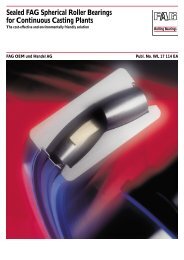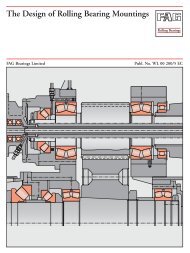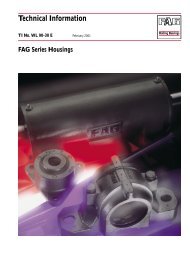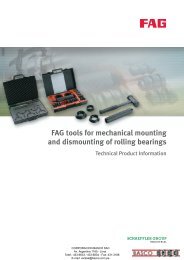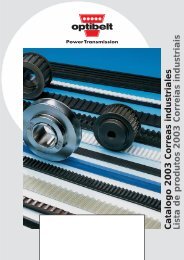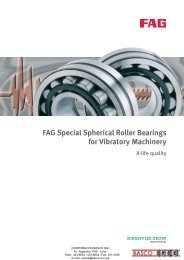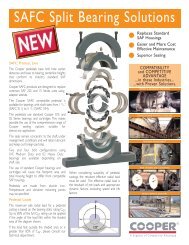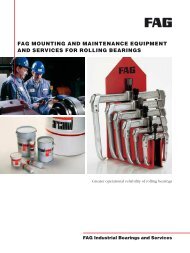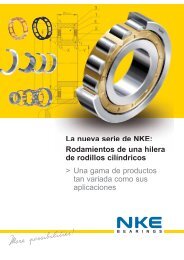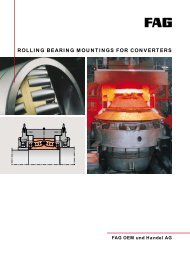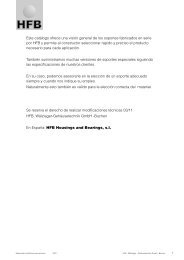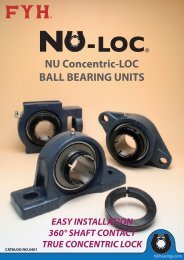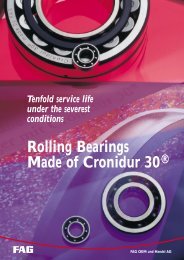75mm to 180mm SPLIT TAPERED BEARINGS
75mm to 180mm SPLIT TAPERED BEARINGS
75mm to 180mm SPLIT TAPERED BEARINGS
- No tags were found...
You also want an ePaper? Increase the reach of your titles
YUMPU automatically turns print PDFs into web optimized ePapers that Google loves.
T e c h ni c a lI n f o r m at i o n<strong>75mm</strong> <strong>to</strong> <strong>180mm</strong>split tapered BEARINGs
introductionThe Cooper split tapered bearing is intended for the ‘fixed’bearing position of shafts where there is both radial and axialloading and our ‘GR’ cylindrical roller bearing is unsuitable.It is constructed with two opposed rows of rollers <strong>to</strong> takeaxial loading in either direction, and is intended <strong>to</strong> be usedwith ‘expansion’ type bearings in all other positions on theshaft.Cooper split tapered roller bearings are generally mountedin a ‘cartridge’ in a similar way <strong>to</strong> Cooper cylindrical rollerbearings. This is a spherically-machined inner housing that canbe fitted in<strong>to</strong> a number of types of outer housing.The spherical seat between the cartridge and the outerhousing accommodates misalignment between the shaft andmounting structure.The cartridge also houses the seals. This ensures that the sealsare maintained concentric <strong>to</strong> the shaft, even if there is significantmisalignment of the shaft relative <strong>to</strong> the outer housing.Cartridges for tapered bearings are fitted with a holein communication with the outer race, for fitment of atemperature element, as standard. The standard hole positionis in the end face of the cartridge. The proximity of this hole<strong>to</strong> the shaft means that if the temperature element is of theheaded type, generally it will need <strong>to</strong> have a cranked probe.Alternative hole positions are possible, including radial holesrequiring additional holes in the outer housing.Outer HousingsTapered bearing in cartridgeAs the cartridge spherical seat diameters are common <strong>to</strong> theseats for Cooper cylindrical bearings, the bearing and cartridgeunit can be fitted in a wide variety of existing housing designs.However, the two types most commonly used are thepedestal (or ‘pillow block’) and flange.Pedestal CapPedestal (or ‘pillow block’)CartridgeCage and rollersOuter raceClampingringsInner racePedestalBaseSeals (variousoptionsavailable)ShaftFlangeDuctile iron pillow blocks and flanges are offered as standardwith these bearings. Please confirm load capacities of housingswith our technical department before finalising designs.
<strong>75mm</strong> <strong>to</strong> <strong>180mm</strong>Split tapered BEARINGsBulkhead sealingIt is often found economical <strong>to</strong> combine a bearing andbulkhead seal in<strong>to</strong> one unit. This reduces the number ofindividual units required, and prevents problems with shafteccentricity sometimes encountered at the bulkhead seal whenit is separated from the bearing.Generally, a specially adapted flange mounting is used and thebearing is fitted with SRSRP seals (see page 6). Generally, theflange incorporates additional sealing <strong>to</strong> the cartridge seating,and may include sealing on the mounting face (‘backface’).Where the shaft surface speed is <strong>to</strong>o high for standardSRSRP seals, an alternative high speed version is available, oralternative seal types can be used if a moderate leakage ofwater is permitted through the bearing in an emergency.Sealing <strong>to</strong> flange mounting face (“BFS”)Sealing <strong>to</strong> swivel seating (“SSE”)SRSRP SealCombined bearing and bulkhead sealBearing SelectionBearing ratings for dynamic radial capacity (Cr) and static radialcapacity (Cor) shown in this leaflet are in accordance with ISO281-1990 and ISO 76-1987 respectively.Radial and axial loads must be considered <strong>to</strong>gether ascombined ‘equivalent loads’, as explained below. Generally,maximum instantaneous loading is governed by housingstrength rather than bearing static capacity.Dynamic ratingExpected bearing life is calculated by the following equation:L10 = [Cr/(P x fd)] (10/3)where:L10 = expected life of 90% of similar bearingsunder similar operating conditionsCr = radial dynamic ratingP = equivalent dynamic loadfd = dynamic or service fac<strong>to</strong>r, generally from1 for steady loading <strong>to</strong> 3.5 for heavy shock,reciprocation or vibrationThe dynamic equivalent load is calculated as follows:when F a /F r ≤e :when F a /F r >e :P = F r + Y 1 F aP = 0.67F r + Y 2 F awhere:F r = applied radial loadF a = applied axial loadand calculation fac<strong>to</strong>rs Y 1 , Y 2 and e are given in the productdata tables.Life calculation with multiple load conditionsWhere varying loads are experienced in operation, using themaximum load condition may lead <strong>to</strong> an unrealistically lowcalculated life. For n load conditions constituting the full loadcycle (at constant speed), an overall dynamic equivalent loadmay be calculated as follows:i=n0.3P = [∑P (10/3) i p i ]where:P ip ii=1= dynamic equivalent load under loadcondition i= proportion of time load condition i isapplicableWhere the load is continuously variable it may be brokendown in<strong>to</strong> a discrete approximation <strong>to</strong> the actual load cycle.Minimum loadingIn order <strong>to</strong> avoid excessive skidding of the rollers, sufficientloading must be applied <strong>to</strong> the bearing, as follows:P ≥ 0.01Cr2
Static ratingThe static load rating is defined as the load at which a contactstress of 4GPa occurs at the centre of the most heavilyloaded contact, and at which a permanent deformation of0.0001 times the roller diameter is sustained at the locationof the contact. This has been found <strong>to</strong> not cause significantdeterioration in bearing performance under typical operatingconditions.The suitability of a bearing for sustaining a specified static (orinstantaneous maximum) load is determined as follows:where:C or ≥ S o x P oC orS oP o= static radial capacity= static safety fac<strong>to</strong>r= F r + Y o F a where calculation fac<strong>to</strong>r Y o isgiven in the product data tables.Standard shaft design3Temperature CharacteristicsStandard bearings can operate at between -20°C and 100°C.Operation outside this range is possible but may requirespecial treatment of bearings parts – please contact ourtechnical department.The difference in temperature between the shaft and housingshould not exceed 40°C.Standard shaft design with ATL seals(where applicable)Mounting ArrangementsGeneral arrangementsIn order <strong>to</strong> provide accurate and positive location of theinner race on the shaft, these bearings are generally mountedon a recessed journal, and the standard cartridges and sealsare designed <strong>to</strong> suit this arrangement. As the bearings arecompletely split <strong>to</strong> the shaft, there is no need <strong>to</strong> provideseparate collars <strong>to</strong> create this recess – it can be machineddirectly in<strong>to</strong> a solid shaft. Also, there is no need <strong>to</strong> design thesurrounding parts <strong>to</strong> allow for axial assembly of the bearingand it can be fitted between integral shaft flanges, cranks,mounted parts and assemblies etc.Usually, the shaft is carried through the end of the cartridgeat the diameter of the journal abutment, with the sealsoperating on this larger diameter. If aluminium triple labyrinth(ATL) seals are <strong>to</strong> be used, on some sizes the diameter of thecartridge end bore would be excessive with this arrangement,so the shaft has only narrow shoulders abutting the inner race,with the seals operating on a diameter equal <strong>to</strong> the journaldiameter.Shaft design for ATL sealswhere standard not applicableIf the journal and the portions of the shaft under the sealsare required <strong>to</strong> be of the same diameter and integral abuttingshoulders are not possible, alternatives are <strong>to</strong> use spirallywound retaining rings mounted in grooves in the shaft, orspecial split location collars (usually requiring special cartridges<strong>to</strong> accommodate them). It may be possible <strong>to</strong> locate theinner race on the shaft using only the clamping effort providedby the inner race clamping rings, without auxiliary locationfeatures, but this should only be done in consultation withCooper technical department.
<strong>75mm</strong> <strong>to</strong> <strong>180mm</strong>Split tapered BEARINGsUse of retaining rings<strong>to</strong> locate inner raceAll arrangements not conforming <strong>to</strong> the standard designsillustrated in the product data tables will require confirmationof dimensions and part codes for the cartridges and seals.Use of split collars<strong>to</strong> locate inner raceAlternative abutment diameters can be accommodated usingalternative seals and housing end bores. If larger shaft filletradii are required, we can supply bearings with extra largechamfers <strong>to</strong> the inner race bores.Shaft <strong>to</strong>leranceShaft <strong>to</strong>lerances are as illustrated opposite. The <strong>to</strong>lerance onroundness and parallelism of the journal is IT6.A <strong>to</strong>lerance of h9 is applicable <strong>to</strong> the seal seating area evenwhen it is the same nominal diameter as the journal.4diameterover 50 80 120 180(mm)Toleranceband (<strong>to</strong>BS 4500)up <strong>to</strong> and incl. 80 120 180 250h6+0 +0 +0 +0-19 -22 -25 -29h9+0 +0 +0 +0-74 -87 -100 -115C +0.340+0.120d (h6)A (h9)IT6 19 22 25 29max. shaft fillet radii:<strong>75mm</strong> bore size: 1.2mmall others: 2.3mmStandard shaft design
SealingStandard Cooper housed tapered bearing units incorporatea cartridge with spherical seating, which maintains the sealsconcentric with the shaft under misaligned conditions.Compared <strong>to</strong> units where the misalignment is taken upbetween the bearing and outside housing, closer runningclearances (in non-contact seals) or more even seal pressurecan be maintained.Grease groove (LAB)Supplied as standard. Suitable for high or slow speedoperations. Particularly successful on marine applicationswhen conditions are clean and dry.5Cooper offer a wide range of seals, <strong>to</strong>gether suitable for mostenvironments. Some of the more common options are shownbelow. Further types, or combinations of seals, are possible.Different cartridges are required depending upon seal type.Felt, high temperature packing and single lip (SRS) seals all usea common cartridge.If felt seal are specified, these are supplied with the cartridge(although they can still be ordered separately). Otherseal types must be ordered separately (i.e. they are notau<strong>to</strong>matically supplied with the cartridge).Maximum operating speeds of the various types of sealsare specified in dn(mm). To calculate the speed in dn(mm)multiply the shaft speed (in rpm) by the diameter of the sealseating area (in mm).Temperature limitsMaximum speedShaft surface finish(max. roughness)Felt (F)bearing maximumbearing maximum3.2µm RaSuitable for dry, dusty conditions.Temperature limits -70°C <strong>to</strong> 100°CMaximum speedShaft surface finish(max. roughness)150,000 dn(mm)1.6µm Ra
<strong>75mm</strong> <strong>to</strong> <strong>180mm</strong>Split tapered BEARINGsHigh temperature packing (HTP)A direct replacement for felt in high temperature applications,or for use in fire-resistant bulkheads.Synthetic rubber single lip (SRS)High temperature version (SRS HT)Low temperature version (SRS LT)Suitable for wet but not submerged conditions. Can be usedfor improved lubricant retention by mounting lip inwards.Temperature limits -70°C <strong>to</strong> 260°CMaximum speedShaft surface finish(max. roughness)150,000 dn(mm)0.8µm RaTemperature limitsMaximum speedShaft surface finish(max. roughness)SRSSRS HTSRS LT150,000 dn(mm)0.8µm Ra-20°C <strong>to</strong> 100°C-20°C <strong>to</strong> 175°C-60°C <strong>to</strong> 100°CAluminium triple labyrinth (ATL)High temperature version (atl HT)Low temperature version (atl LT)Machined aluminium bodied triple labyrinth seal for high speedand general applications.Spring-loaded single lip with retaining plate (SRSRP)High pressure version (SRSRP 40M)Suitable for severe splash or completely submerged conditions.The standard version is suitable for up <strong>to</strong> 2m of water.The high pressure version is suitable for up <strong>to</strong> 40m of water.6Temperature limitsMaximum speedShaft surface finish(max. roughness)ATLATL HTATL LTbearing maximum3.2µm Ra-20°C <strong>to</strong> 100°C-20°C <strong>to</strong> 175°C-60°C <strong>to</strong> 100°CTemperature limits -20°C <strong>to</strong> 100°CMaximum speedShaft surface finish(max. roughness)150,000 dn(mm)0.4µm Ra
BEARING dataBCDd7bearing dataShaftDiameterd (mm)ReferenceCr(kN)Bearing Ratings Calculation Fac<strong>to</strong>rs Principal DimensionsCor(kN)Max. Speed(rpm)Y1 Y2 e Yo75 1DTB75M 143 208 3410 1.27 1.89 0.53 1.24 135 82.6 35 4.080 1DTB80M 152 232 3200 1.20 1.79 0.56 1.18 145 85 35 4.690 1DTB90M 160 254 2840 1.11 1.65 0.61 1.08 150 85 35 4.7100 1DTB100M 235 379 2560 1.17 1.75 0.58 1.15 175 100 40 8.3110 1DTB110M 282 504 2330 1.05 1.56 0.64 1.02 190 110 48 11.4120 1DTB120M 295 544 2130 1.00 1.49 0.68 0.98 200 110 48 11.9140 1DTB140M 296 555 1830 1.27 1.90 0.53 1.24 215 110 45 12.2160 1DTB160M 350 670 1600 1.34 1.99 0.50 1.31 240 110 45 14.8180 1DTB180M 358 716 1420 1.21 1.80 0.56 1.18 265 110 45 17.0D(mm)C(mm)B(mm)Mass(Kg)
cartridge dataLL1L1L2Jw (max.)GAdAType 1Type 2hole for temperature elementdrilled Ø6.2 thro’ and tapped G1/8 x 12 deep8cartridge dataabutmentCartridge forLAB sealsReferences (1)Cartridge forATL sealsShafttype(2)G(mm)J(mm)Principal Dimensions1DTC75M-80M 1DTC05 2 177.80 50 138 140 162 11.8 80 71DTC80M-90M 1DTC06-80M 1 203.20 50 140 142 164 15.1 90 -1DTC90M-100M 1DTC06-90M 2 203.20 50 146 148 170 13.5 100 7.51DTC100M-110M 1DTC07 2 231.78 64 170 172 202 20.1 110 7.51DTC110M-120M 1DTC08-110M 1 266.70 76 178 180 210 29.8 120 -1DTC120M-130M 1DTC08-120M 1 266.70 76 178 180 210 26.5 130 -1DTC140M-150M 1DTC09 2 279.40 76 190 192 222 31.2 150 101DTC160M-170M 1DTC11 2 311.15 76 200 202 232 47.0 170 101DTC180M-195M 1DTC31 2 336.55 95 200 206 232 42.5 195 9L(mm)L1(mm)L2(mm)Mass(Kg)A(mm)w (2)(mm)1) For other seal types add seal type designation <strong>to</strong> end of reference for cartridge for LAB sealse.g.120mm cartridge with SRSRP seals: 1DTC120M-130M SRSRP2) Only applicable when fitted with TL seals. All other seal types run on shaft diameter A.
PEDESTALSOOSPHTRNRN9Note: Pedestals with solid bases also available.pedestal dataShaftDiameterd (mm)BearingReferenceReference (1)(pedestal only)H(mm)Min.(mm)RMax.(mm)S(mm)No.BoltsSizeN(mm)O(mm)P(mm)T(mm)Mass(pedestal only)(Kg)75 1DTB75M PN05 112 312 328 - 2 M24 380 90 44 252 13.380 1DTB80M PN06 125 342 366 - 2 M24 420 102 52 272 14.790 1DTB90M PN06 125 342 366 - 2 M24 420 102 52 272 14.7100 1DTB100M PN07 143 374 410 - 2 M24 466 120 60 314 20.6110 1DTB110M PN08 162 438 462 120 4 M24 508 178 38 372 43.3120 1DTB120M PN08 162 438 462 120 4 M24 508 178 38 372 43.3140 1DTB140M PN09 181 470 494 120 4 M24 558 178 41 405 52160 1DTB160M PN11 213 356 380 114 4 M24 508 178 32 430 53180 1DTB180M PN31 210 546 570 128 4 M24 636 204 50 470 831) For lubrication point <strong>to</strong> spherical seating add ‘SLUB’ <strong>to</strong> reference, e.g. PN08 SLUB
FLANGESR PCD,holes equally spacedPLVTNdH10flange bearing dataShaftDiameterd (mm)BearingReferenceReference (1)(flange only)T (2)(mm)BoltSizeR(mm)P(mm)H(mm)N (3)(mm)V (3)(mm)Mass(flange only)(Kg)75 1DTB75M FN05 330 M16 274 19 79 215.90 3 19.480 1DTB80M FN06 356 M16 302 19 86 244.48 3 22.090 1DTB90M FN06 356 M16 302 19 86 244.48 3 22.0100 1DTB100M FN07 382 M16 334 22 92 276.23 3 26.6110 1DTB110M FN08 432 M24 374 22 98 314.33 3 34.9120 1DTB120M FN08 432 M24 374 22 98 314.33 3 34.9140 1DTB140M FN09 444 M24 384 25 98 317.50 3 40.8160 1DTB160M FN11 496 M24 426 25 105 352.43 3 58180 1DTB180M FN31 534 M24 466 25 124 393.70 3 811) For lubrication point <strong>to</strong> spherical seating add ‘SLUB’ <strong>to</strong> reference, e.g. FN08 SLUB2) Dimension shown is as-cast dimension. Depending upon manufacturing method used, flanges supplied may be machined 5mm smaller3) Dimensions shown are for locating spigot for mounting flange on <strong>to</strong>. Diameter <strong>to</strong>lerance of locating spigot: f8Where SRSRP seals are used cartridge assembly may protrude in<strong>to</strong> bulkhead. Consult Cooper for minimum bulkhead aperture size.
LubricationFittingsLubrication points are tapped 1/8”NPT and fitted with nipplesfor grease lubrication as standard. Grease nipples may beremoved and replaced with other fittings or pipes. Pipeworkmust be flexible <strong>to</strong> allow the swivel cartridge <strong>to</strong> functioncorrectly.BSP fittings may be used, but care must be taken <strong>to</strong> avoidblocking off the lubricant cross-drilling as these fittingsgenerally screw in further than NPT fittings.Lubricant typeCooper tapered bearings and housings are designed for greaselubrication. Grease is easier <strong>to</strong> retain in the housing thanoil, offering reduced lubricant loss and improved sealing. Italso offers better protection against corrosion <strong>to</strong> the rollingsurfaces.Greases of NLGI No.2 designation are recommended formost applications. For centrally pumped systems a No.1grease may be used for increased ‘pumpability’.Greases with extreme pressure (EP) additives arerecommended.11Grease with a lithium complex thickener is usually used fornormal applications operating at temperatures between0°C and 80°C. When water resistance is required a greasewith aluminium complex thickener can be used. Aluminiumcomplex greases are not compatible with some other typesof grease. The bearing must therefore be solvent cleaned ofother greases before adding an aluminium complex basedgrease.For extreme temperatures, speeds and loads always obtain alubricant recommendation from our technical department.Selection of base oil viscosityIn order for the bearing <strong>to</strong> have a long service life the greaseselected for bearing lubrication must have a base oil ofsufficiently high viscosity <strong>to</strong> adequately separate the rollingelements and race parts under operating conditions.The charts in Figure 2 show the recommended operatingranges for three common oil viscosities, for bearings undernormal loading (up <strong>to</strong> Cr/10).geometry fac<strong>to</strong>rShaft Diameterd (mm)BearingReferenceGeometryfac<strong>to</strong>r75 1DTB75M 6380 1DTB80M 6990 1DTB90M 78100 1DTB100M 96110 1DTB110M 110120 1DTB120M 118140 1DTB140M 144160 1DTB160M 169180 1DTB180M 196For example, if a 100mm bearing is <strong>to</strong> be run at 1200rpm:The geometry fac<strong>to</strong>r is 96 from the tableVelocity fac<strong>to</strong>r = 96 x (1200/1000) = 115.2To determine the suitability of one of these oils, draw avertical line from the horizontal axis at the calculated velocityfac<strong>to</strong>r, and draw a horizontal line from the vertical axis at theoperating temperature.If the lines intersect in the shaded area the viscosity of oil issuitable. If the lines intersect above the shaded area a higherviscosity oil is required. If the lines intersect below the shadedarea the bearing may operate satisfac<strong>to</strong>rily but it is suggestedthat a grease with a lower viscosity base oil is used.The use of these charts is subject <strong>to</strong> the operating conditionsbeing within the recommended ranges for the lubricant asspecified by the lubricant manufacturer.For conditions not covered by these charts please contact ourtechnical department.Note that the lubrication film thickness is not particularlysensitive <strong>to</strong> load, so for heavier loading the lubricant selectionas provided by these charts is usually sufficient providedthat the lines drawn on the chart as explained above do notintersect at the upper edge of the shaded area.To use these charts, find the ‘geometry fac<strong>to</strong>r’ for the bearingfrom the table below and multiply this by the bearing speed inthousands of rpm <strong>to</strong> obtain the velocity fac<strong>to</strong>r.
<strong>75mm</strong> <strong>to</strong> <strong>180mm</strong>Split tapered BEARINGsFigure 2Cooper Bearing recommended speedand temperature range for VG 150grease and oilsTemperature (°C)1201101009080706050403020100-10-200 20 40 60 80 100 120 140 160 180 200 220 240 260 280 300Velocity fac<strong>to</strong>r = geometry fac<strong>to</strong>r X rpm in thousandsCooper Bearing recommended speedand temperature range for VG 220grease and oilsTemperature (°C)1201101009080706050403020100-10-200 20 40 60 80 100 120 140 160 180 200 220 240 260 280 30012Velocity fac<strong>to</strong>r = geometry fac<strong>to</strong>r X rpm in thousandsCooper Bearing recommended speedand temperature range for VG 460grease and oilsTemperature (°C)1201101009080706050403020100-10-200 20 40 60 80 100 120 140 160 180 200 220 240 260 280 300Velocity fac<strong>to</strong>r = geometry fac<strong>to</strong>r X rpm in thousands
Grease quantity for initial lubricationThe quantity of grease required on initial lubrication isdependent upon operating speed and temperature.If the operating temperature is below 80°C the quantity ofgrease may be determined directly according <strong>to</strong> the bearingreference and operating speed from the table below. If theoperating temperature is above 80°C a 25% pack of greaseshould be used regardless of operating speed (refer <strong>to</strong> theright hand column of the table).With a ‘full pack’ of grease the space within the housing (i.e.surrounding the bearing components) in the assembled unit iscompletely filled with grease.The table assumes normal density grease (about 0.85 g/cm 3 ).Initial lubricant quantitiesRoutine GreasingRelubricate the bearing weekly or every 150 hours ofoperation.Sizes up <strong>to</strong> and including 120mm: Use 2ml of fresh grease.Sizes over 120mm: Use 4ml of fresh grease.Note that 2ml is approximately 1 shot from a conventionalside-lever grease gun.Au<strong>to</strong>matic lubrication systems should be metered <strong>to</strong> delivergrease at an average rate equivalent <strong>to</strong> the routine greasingperiods and quantities specified.If it can be done safely, the bearing should be re-greased as itrotates <strong>to</strong> help distribute the grease.Do not mix different types of grease in the bearing. Excessivequantities of lubricant should not be used, particularly athigh speeds, as this may result in excessive churning andoverheating.ShaftDiameterd (mm)BearingReferenceSpeed(rpm)up <strong>to</strong>Grease(full pack)(Kg)Speed (rpm)Grease(75% fullpack) (Kg)Speed (rpm)Grease(50% fullpack) (Kg)Speed (rpm)from <strong>to</strong> from <strong>to</strong> from <strong>to</strong>Grease(33% fullpack) (Kg)Speed(rpm)overGrease(25% fullpack) (Kg)75 1DTB75M 667 0.19 667 1333 0.14 1333 2000 0.10 2000 2667 0.06 2667 0.0580 1DTB80M 625 0.23 625 1250 0.17 1250 1875 0.12 1875 2500 0.08 2500 0.061390 1DTB90M 556 0.25 556 1111 0.19 1111 1667 0.12 1667 2222 0.08 2222 0.06100 1DTB100M 500 0.41 500 1000 0.31 1000 1500 0.20 1500 2000 0.13 2000 0.10110 1DTB110M 455 0.44 455 909 0.33 909 1364 0.22 1364 1818 0.14 1818 0.11120 1DTB120M 417 0.50 417 833 0.38 833 1250 0.25 1250 1667 0.17 1667 0.13140 1DTB140M 357 0.65 357 714 0.48 714 1071 0.32 1071 1429 0.21 1429 0.16160 1DTB160M 313 0.63 313 625 0.47 625 938 0.32 938 1250 0.21 1250 0.16180 1DTB180M 278 0.77 278 556 0.58 556 833 0.39 833 1111 0.25 1111 0.19Frequency DataBearing frequency data are included in this document for twopurposes:• <strong>to</strong> allow machine designers <strong>to</strong> check excitation frequenciesagainst resonant frequencies in the machine,• <strong>to</strong> allow correct input in<strong>to</strong> condition moni<strong>to</strong>ringequipment that uses these data.A roller bearing will excite vibrations at certain frequenciesrelated <strong>to</strong> the number, size and pitch circle diameter of therollers. To some extent this excitation is present even withnew bearings in perfect condition, as the load is carried ondiscrete, elastic, rolling elements which are constantly changingin angular position.The table at the <strong>to</strong>p of the page opposite indicates thefrequencies of bearing parts per shaft revolution, which can beused <strong>to</strong> calculate excitation frequencies directly by multiplyingthe tabulated frequencies by the shaft speed.The frequencies listed are explained as follows:‘Cage’ – the frequency at which a point on the cage enters andleaves the loaded zone of the bearing‘Roller’ – the frequency at which a point on a given rollerpasses in<strong>to</strong> contact with either the inner or outer race‘Outer’ – the frequency at which a point on the outer racecomes in<strong>to</strong> contact with successive rollers‘Inner’ – the frequency at which a point on the inner racecomes in<strong>to</strong> contact with successive rollersThe table also lists the pitch circle diameters, number of rollersand contact angle for use with condition moni<strong>to</strong>ring equipmentthat accepts this information.
cUSTomer SerVice cenTreSGermanyCooper Geteilte rollenlager GmbH.postfach 100 423Oberbenrader str. 40747704 KrefeldGerMaNYtel: +49 (0) 2151 713 016Fax: +49 (0) 2151 713 010Email: CoopersalesDE@kaydon.comCOOper BeariNGs GrOupUK, Europe, South America, Asia,Australia and the Middle EastCooper roller Bearings Company ltd.Wisbech roadKings lynnNorfolkpe30 5JXunited Kingdomtel: +44 (0) 1553 763447Fax: +44 (0) 1553 761113Email: CoopersalesUK@kaydon.comUSA, Canada, Mexicoand Central Americathe Cooper split roller Bearing Corp.5365 robin Hood roadsuite BNorfolkVa 23513usa.tel: +1 (1) 757 460 0925Fax: +1 (1) 757 464 3067Email: CoopersalesUS@kaydon.comPeople’s Republic of ChinaCooper Bearings Group Beijing.room 909, Canway Building <strong>to</strong>wer 1No 66, Nanlishi roadXicheng districtBeijingprC 100045tel: +86 (0) 10 68080803+86 (0) 10 68080805+86 (0) 10 68080806Fax: +86 (0) 10 68080801Email: CoopersalesCN@kaydon.comBrazilCooper do Brasil ltda.Caixa postal 66.105Cep 05.314-970Brasiltel: +55 (0) 11 3022 3706tel: +55 (0) 11 9156 2500Email: CoopersalesBR@kaydon.comIndiaCooper roller Bearings Company ltd.Wisbech roadKings lynnNorfolkpe30 5JXunited Kingdomtel: +91 (0) 9820180089Email: CoopersalesIN@kaydon.comwww.cooperbearings.comdocument code: Cpr013_aeng_aug10



